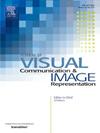Contrastive attention and fine-grained feature fusion for artistic style transfer
IF 2.6
4区 计算机科学
Q2 COMPUTER SCIENCE, INFORMATION SYSTEMS
Journal of Visual Communication and Image Representation
Pub Date : 2025-04-11
DOI:10.1016/j.jvcir.2025.104451
引用次数: 0
Abstract
In contemporary image processing, creative image alteration plays a crucial role. Recent studies on style transfer have utilized attention mechanisms to capture the aesthetic and artistic expressions of style images. This method converts style images into tokens by initially assessing attention levels and subsequently employing a decoder to transfer the artistic style of the image. However, this approach often discards many fine-grained style elements due to the low semantic similarity between the original and style images. This may result in discordant or conspicuous artifacts. We propose MccSTN, an innovative framework for style representation and transfer, designed to adapt to contemporary arbitrary image style transfers as a solution to this problem. Specifically, we introduce the Mccformer feature fusion module, which integrates fine-grained features from content images with aesthetic characteristics from style images. Mccformer is utilized to generate feature maps. The target image is then produced by inputting the feature map into the decoder. We consider the relationship between individual styles and the overall style distribution to streamline the model and enhance training efficiency. We present a multi-scale augmented contrast module that leverages a substantial number of image pairs to learn style representations. Code will be posted on https://github.com/haizhu12/MccSTN
对比关注与细纹特征融合,实现艺术风格的传递
在当代图像处理中,创造性的图像变换起着至关重要的作用。最近关于风格迁移的研究利用注意机制来捕捉风格图像的审美和艺术表达。这种方法将风格图像转换为符号,首先评估注意力水平,然后采用解码器转移图像的艺术风格。然而,由于原始图像和样式图像之间的语义相似性较低,这种方法往往会丢弃许多细粒度的样式元素。这可能导致不协调或明显的伪影。为了解决这一问题,我们提出了一个创新的风格表达和转换框架MccSTN,旨在适应当代随意的图像风格转换。具体来说,我们引入了mcformer特征融合模块,该模块将内容图像中的细粒度特征与样式图像中的美学特征相结合。Mccformer用于生成特征图。然后通过将特征映射输入解码器生成目标图像。我们考虑了个人风格和整体风格分布之间的关系,简化了模型,提高了训练效率。我们提出了一个多尺度增强对比度模块,它利用大量的图像对来学习风格表征。代码将发布在https://github.com/haizhu12/MccSTN上
本文章由计算机程序翻译,如有差异,请以英文原文为准。
求助全文
约1分钟内获得全文
求助全文
来源期刊

Journal of Visual Communication and Image Representation
工程技术-计算机:软件工程
CiteScore
5.40
自引率
11.50%
发文量
188
审稿时长
9.9 months
期刊介绍:
The Journal of Visual Communication and Image Representation publishes papers on state-of-the-art visual communication and image representation, with emphasis on novel technologies and theoretical work in this multidisciplinary area of pure and applied research. The field of visual communication and image representation is considered in its broadest sense and covers both digital and analog aspects as well as processing and communication in biological visual systems.
 求助内容:
求助内容: 应助结果提醒方式:
应助结果提醒方式:


